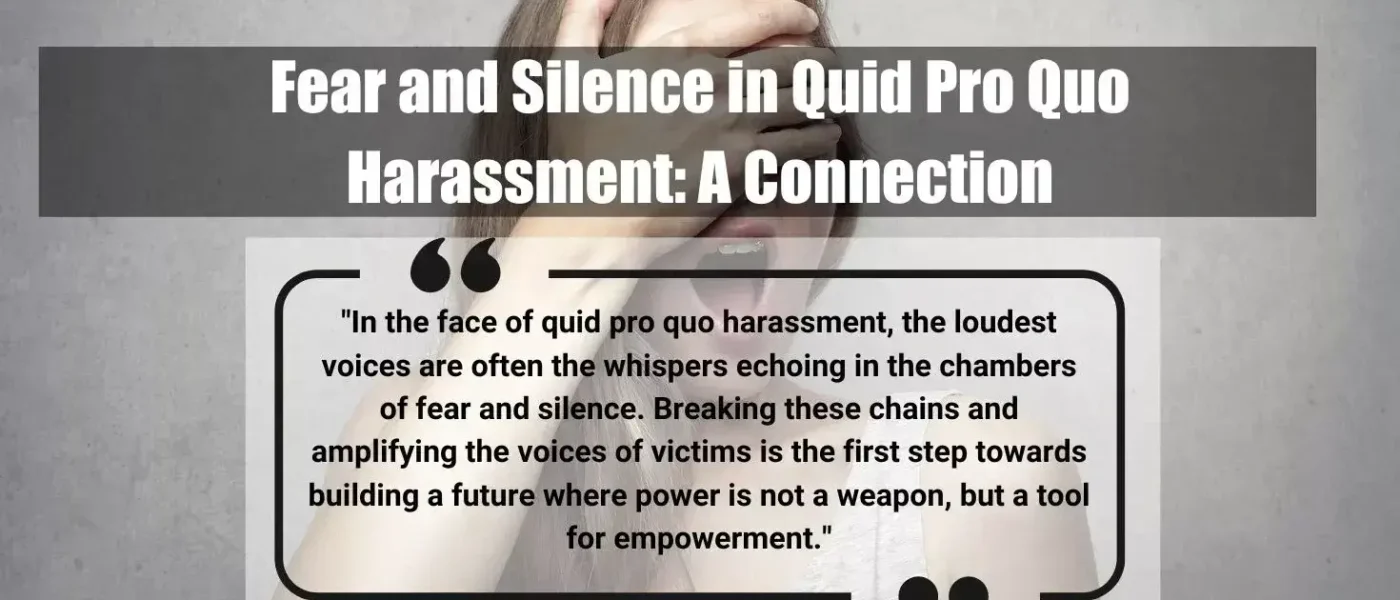Key Takeaways from the Article:
- Power Dynamics: Quid pro quo harassment thrives on power imbalances, with perpetrators exploiting their authority to coerce victims into compliance, perpetuating fear and silence.
- Psychological Impact of Fear: Fear serves as a potent tool in perpetuating harassment, controlling victims, and preventing reporting. It triggers emotional distress, anxiety, and self-doubt, often leading to long-term psychological consequences such as PTSD.
- Cycle of Fear and Silence: Fear and silence form a vicious cycle, with victims minimizing the seriousness of harassment, blaming themselves, avoiding the perpetrator, and denying the impact, further empowering the perpetrator.
- Role of Social Factors: Workplace culture, lack of reporting mechanisms, fear of retaliation, and societal stigma contribute to silencing victims, making it difficult for them to speak out against harassment.
- Empowerment and Advocacy: Breaking the silence requires strategies for empowerment, including building individual resilience, fostering open communication, strengthening reporting mechanisms, and promoting collective action through bystander intervention.
- Creating a Safer Future: Addressing fear and silence is essential for protecting victims, holding perpetrators accountable, creating safer environments, promoting social change, and ultimately ending quid pro quo harassment.
I. Introduction
Diving into “Fear and Silence in Quid Pro Quo Harassment,” we tackle the power imbalances and societal shackles that keep victims quiet. We expose the psychological scars fear leaves behind and the societal norms that demand silence. The piece champions strategies to enhance resilience, overhaul reporting mechanisms, and cultivate a culture where speaking out is supported, aiming to dismantle power dynamics and silence, forging a path to a safer, more vocal future.
A. Defining Quid Pro Quo Harassment
Quid pro quo harassment, a Latin phrase translating to “this for that,” is a form of sexual harassment occurring within workplaces and educational settings. It constitutes a power dynamic where an individual in a position of authority, such as a supervisor, manager, or professor, demands sexual favors or conduct in exchange for employment benefits or avoidance of detriments. These benefits may include promotions, raises, positive performance reviews, favorable assignments, or continued employment. Conversely, the detriments could involve demotions, pay cuts, negative evaluations, undesirable tasks, or even termination.
While the specific legal language surrounding quid pro quo harassment may differ slightly across jurisdictions, the underlying principle remains consistent: it involves the exchange of sexual favors for professional benefits or detriments. Notably, quid pro quo harassment extends beyond explicit acceptance of advances, encompassing situations where the mere suggestion or pressure to engage in such conduct creates a hostile work environment.
Examples of quid pro quo harassment include:
- A supervisor offering a promotion to an employee in exchange for sexual favors.
- A manager threatens to fire an employee if they refuse to engage in sexual activity.
- A professor demands sexual favors from a student in exchange for a good grade.
- A colleague repeatedly makes unwelcome sexual advances despite clear rejection.
It’s crucial to acknowledge that quid pro quo harassment can involve various forms of sexual conduct beyond explicit intercourse. This includes unwanted touching, groping, suggestive comments, sexual jokes, and requests for sexual favors. Additionally, same-sex harassment and harassment based on gender identity also fall under the umbrella of quid pro quo harassment.
Quid Pro Quo and Hostile Work Environment
II. Understanding the Power Dynamics

Power imbalances are inherent to quid pro quo harassment, as the perpetrator leverages their authority to exploit the victim. This dynamic creates an environment where the victim feels pressured or even coerced into complying with the perpetrator’s demands out of fear of retaliation or negative consequences.
The power imbalance can manifest in various ways:
- Hierarchical structures: In workplaces, supervisors hold significant power over their employees, creating an inherent disparity in control.
- Economic dependence: Employees often rely on their jobs for financial stability, making them vulnerable to pressure from superiors.
- Academic dependence: Students may depend on professors for good grades and academic success, making them susceptible to exploitation.
- Lack of awareness and support: Victims may be unaware of their rights or lack access to proper support systems, further inhibiting their ability to resist or report the harassment.
Understanding the power dynamics is crucial to addressing quid pro quo harassment effectively. By recognizing the inherent inequality and the psychological pressure experienced by victims, we can develop better strategies for prevention, intervention, and support.
III. The Prevalence and Impact of Silence
Despite legal protections against quid pro quo harassment, it remains a pervasive problem across various workplaces and educational institutions. Studies reveal that a significant portion of employees and students have experienced some form of quid pro quo harassment, with many choosing to remain silent due to fear, shame, and lack of trust in reporting systems.
The silence surrounding quid pro quo harassment has detrimental consequences on both individual and societal levels:
- Psychological trauma: Victims often experience emotional distress, anxiety, depression, and even post-traumatic stress disorder due to the harassment.
- Damaged careers and academic performance: Quid pro quo harassment can hinder professional advancement, academic progress, and well-being.
- Organizational costs: Harassment can lead to decreased productivity, increased employee turnover, and potential legal repercussions for organizations.
- Perpetuation of power abuse: The silence surrounding harassment allows the cycle of abuse to continue, encouraging perpetrators and discouraging victims from coming forward.
Addressing the issue of silence requires a multifaceted approach. This includes raising awareness, fostering a culture of open communication, establishing safe reporting channels, and providing victims with the necessary support and resources to overcome the fear and shame of coming forward.
IV. The Psychological Impact of Fear

A. Fear as a Tool of Perpetuation
Fear serves as a potent tool for perpetrators of quid pro quo harassment. They leverage fear to:
- Control and manipulate victims: By instilling fear of consequences, perpetrators can coerce victims into compliance and silence.
- Prevent reporting: Fear of retaliation, disbelief, or victim blaming can deter victims from seeking help or reporting the harassment.
- Maintain the power imbalance: Fear keeps victims powerless and unable to challenge the perpetrator’s authority.
The psychological mechanisms of fear involve activating the fight-or-flight response, leading to physiological changes like increased heart rate, sweating, and muscle tension. This physiological response can trigger emotional distress, anxiety, and a sense of helplessness. Additionally, the fear of negative consequences can lead to self-doubt, shame, and a reluctance to disclose the harassment to others.
The long-term effects of fear on mental health can be significant. Victims may experience chronic anxiety, depression, post-traumatic stress disorder (PTSD), and difficulty forming healthy relationships. These psychological consequences can negatively impact their lives, including their well-being, professional development, and social interactions.
B. The Cycle of Fear and Silence
Fear and silence are intricately linked and perpetuate a vicious cycle in quid pro quo harassment cases. The fear of consequences and lack of trust in reporting systems lead victims to remain silent, further empowering the perpetrator and allowing the cycle to continue.
Self-silencing behaviors adopted by victims can include:
- Minimizing the seriousness of the harassment
- Blaming themselves for the perpetrator’s actions
- Avoiding the perpetrator or situations where harassment might occur
- Withdrawing from social interactions and activities
- Denying the impact of the harassment on their mental health
These self-silencing behaviors can exacerbate the psychological impact of the harassment and hinder the healing process. Breaking the cycle of fear and silence requires empowering victims to overcome these challenges and seek help.
C. Emotional and Psychological Consequences
The emotional and psychological consequences of quid pro quo harassment can vary depending on the individual’s personality, coping mechanisms, and past experiences. However, some common effects include:
Emotional distress: Anxiety, depression, anger, guilt, shame, and fear are common emotional responses to harassment.
- Psychological trauma: In severe cases, victims may develop PTSD, characterized by flashbacks, nightmares, intrusive thoughts, and avoidance behaviors.
- Decreased self-esteem: The experience of harassment can erode a person’s sense of self-worth and confidence.
- Difficulty concentrating and making decisions: The emotional and psychological turmoil can impair cognitive function and decision-making abilities.
- Social isolation: Victims may withdraw from social interactions and activities due to fear, shame, or lack of support.
It’s crucial to provide victims with access to mental health professionals and support groups to help them process the emotional trauma and develop healthy coping mechanisms.
D. Individual Differences in Fear Response
Individual differences in personality traits and past experiences significantly affect how people respond to fear in quid pro quo harassment. Some factors that can influence fear response include:
- Resilience: Individuals with strong coping mechanisms and resilience are better equipped to manage fear and take steps to address the harassment.
- Personality traits: Individuals with higher levels of neuroticism and anxiety may experience heightened fear and distress in response to harassment.
- Past experiences: Victims of previous harassment or trauma may be more susceptible to fear and anxiety in similar situations.
Understanding these differences allows for a more tailored approach to supporting victims and addressing their needs. By recognizing the factors that influence fear response, we can develop more effective strategies for intervention and prevention.
V. The Role of Social Factors in Silencing

A. Workplace Culture and Power Structures
Workplace culture plays a crucial role in either enabling or discouraging the reporting of quid pro quo harassment. Cultures that are characterized by the following factors are more likely to foster silence:
- Lack of transparency and open communication: When employees are afraid to speak up about concerns or feel unheard, they are less likely to report harassment.
- Authoritarian leadership styles: Leaders who create an environment of fear and intimidation can make victims feel powerless and reluctant to challenge the perpetrator.
- Tolerance for inappropriate behavior: If jokes, sexual comments, and other forms of harassment are tolerated in the workplace, it sends the message that such behavior is acceptable.
- Lack of diversity and inclusion: Homogenous workplaces where certain groups are underrepresented can exacerbate the power imbalance and make it more difficult for victims to speak up.
Conversely, workplaces that promote open communication, respect, and diversity can create a safer environment where victims feel comfortable reporting harassment. This can involve implementing clear policies against sexual harassment, training employees and managers, and establishing accessible reporting channels.
B. Lack of Reporting Mechanisms and Support Systems
Many organizations lack adequate reporting mechanisms and support systems for victims of quid pro quo harassment. This can include:
- Complicated and bureaucratic reporting procedures: Victims may be discouraged from reporting if the process is lengthy, time-consuming, or involves interacting with the perpetrator.
- Lack of anonymity and confidentiality: Victims may fear retaliation or disbelief if they are not guaranteed anonymity and confidentiality throughout the reporting process.
- Unresponsive and biased investigators: Victims may be discouraged from reporting if they believe their allegations will not be taken seriously or investigated fairly.
- Inadequate support services: Victims may need access to mental health resources, legal assistance, and other forms of support to cope with the emotional and practical challenges of coming forward.
Strengthening reporting mechanisms and support systems is crucial for empowering victims to speak up and holding perpetrators accountable. This can involve establishing clear reporting procedures, appointing trained investigators, providing ongoing support services, and fostering a culture of trust and transparency within organizations.
C. Fear of Retaliation and Negative Consequences
One of the biggest deterrents to reporting quid pro quo harassment is the fear of retaliation from the perpetrator or the organization. Retaliation can take various forms, including:
- Negative performance reviews: The perpetrator may use their authority to give the victim unfair evaluations, hindering their career advancement.
- Increased workload and assignments: The victim may be subjected to increased workloads or undesirable tasks as punishment.
- Social isolation and exclusion: The perpetrator may spread rumors and isolate the victim from other colleagues.
- Termination of employment: In some cases, the victim may be fired or forced to resign as a result of reporting the harassment.
The fear of retaliation is a legitimate concern that should be addressed seriously. Organizations must have clear policies prohibiting retaliation and ensure such policies are enforced effectively. Additionally, victims need access to legal support and protection from retaliation.
D. Shame, Stigma, and Victim Blaming
Shame, stigma, and victim blaming are societal factors that can further discourage victims from coming forward. Victims may feel ashamed of what happened to them, fear being judged or blamed by others, and doubt their own experiences.
Victim blaming involves placing the responsibility for the harassment on the victim, often by criticizing their behavior or suggesting they provoked the perpetrator. This can be incredibly damaging to the victim’s sense of self-worth and further prevent them from seeking help.
Addressing shame, stigma, and victim blaming requires a multifaceted approach. This can involve raising awareness about the prevalence of quid pro quo harassment, challenging stereotypes and misconceptions, and providing support to victims who feel ashamed or blamed.
VI. Breaking the Silence: Strategies for Empowerment and Advocacy

A. Building Individual Resilience and Coping Skills
Empowering victims and enabling them to confront the fear and silence surrounding quid pro quo harassment requires equipping them with individual resilience and coping skills. These strategies can include:
- Developing self-awareness: Recognizing personal triggers and warning signs can help individuals manage their emotional response to fear and avoid engaging in self-silencing behaviors.
- Building coping mechanisms: Practices like mindfulness, relaxation techniques, and journaling can help individuals manage stress, anxiety, and other emotional responses to harassment.
- Seeking social support: Connecting with trusted friends, family members, or support groups can give victims a sense of validation, understanding, and encouragement.
- Accessing professional help: Mental health professionals can provide victims with individual therapy and support to address the psychological trauma and develop healthy coping mechanisms.
By strengthening individual resilience and providing victims with the tools to manage their emotions and access support, we can empower them to overcome the fear and silence associated with quid pro quo harassment.
B. Fostering a Culture of Open Communication and Support
Creating a culture of open communication and support within organizations and educational institutions is crucial for preventing quid pro quo harassment and encouraging victims to come forward. This can involve:
- Implementing clear and comprehensive policies: Organizations should have clearly defined policies against sexual harassment, including quid pro quo harassment, outlining the reporting procedures, disciplinary actions, and available support services.
- Providing regular training: All employees and students should receive regular training on sexual harassment, including information about what constitutes harassment, how to report it, and available resources.
- Encouraging open dialogue: Leaders should create a safe environment where employees and students feel comfortable discussing their concerns and reporting harassment without fear of retaliation.
- Building trust: Organizations should demonstrate their commitment to addressing harassment by taking all complaints seriously and ensuring fair and impartial investigations.
By fostering a culture of open communication and support, we can create an environment where victims feel safe to come forward and seek help and where perpetrators are held accountable for their actions.
C. Strengthening Reporting Mechanisms and Legal Protections
Effective reporting mechanisms and strong legal protections are essential for encouraging victims to come forward and holding perpetrators accountable. This can involve:
- Establishing confidential and accessible reporting channels: Victims should have multiple options for reporting harassment, including anonymous channels and reporting to individuals outside their chain of command.
- Ensuring fair and impartial investigations: Organizations should have trained investigators to conduct thorough, unbiased investigations into harassment allegations.
- Enforcing clear and consistent disciplinary actions: Organizations should have clear disciplinary policies for perpetrators of harassment, including termination of employment in serious cases.
- Strengthening legal protections: Laws against quid pro quo harassment should be strengthened to ensure victims have access to legal counsel, protection from retaliation, and fair compensation for damages.
By strengthening reporting mechanisms and legal protections, we can create a more just and equitable system where victims are empowered to seek justice and hold perpetrators accountable for their actions.
D. Empowering Victims and Promoting Advocacy
Empowering victims of quid pro quo harassment and promoting advocacy efforts are crucial for creating lasting change. This can involve:
- Providing victims with legal assistance and support services: Victims need access to legal expertise to navigate the reporting process, understand their rights, and pursue legal action if necessary.
- Encouraging victim participation in advocacy efforts: Victims can share their stories and insights to raise awareness about the issue, advocate for policy changes, and support other victims.
- Building a collective voice: By joining forces and speaking out together, victims can amplify their voices, challenge societal norms, and push for more effective solutions to address quid pro quo harassment.
Empowering victims and promoting advocacy creates a powerful force for change, fostering a culture where harassment is not tolerated, and victims have the support and resources they need to overcome their experiences and build a safer future.
Empowering victims also includes providing them with access to mental health professionals who can help them cope with the psychological effects of harassment.
E. Bystander Intervention and Collective Action
Bystander intervention and collective action are crucial in preventing quid pro quo harassment and creating a safer environment for everyone. This can involve:
- Educating bystanders: Bystanders should be trained to recognize the signs of harassment, understand their role in intervening safely and effectively, and report the incident to appropriate authorities.
- Providing resources and support: Bystanders need access to resources and training to equip them with the skills and knowledge to intervene effectively.
- Holding perpetrators accountable: Bystanders should speak up and challenge inappropriate behavior, regardless of the perpetrator’s position or authority.
- Empowering collective action: Bystanders can work together to create a culture of respect and zero tolerance for harassment within their communities and workplaces.
Bystander intervention and collective action have the potential to significantly reduce the prevalence of quid pro quo harassment and create a safer and more equitable environment for everyone.
Ultimate Bystander Intervention Training (BIT)
VII. Concluding Fear and Silence in Quid Pro Quo Harassment
A. The Importance of Addressing Fear and Silence
Addressing the fear and silence surrounding quid pro quo harassment is crucial for several reasons:
- Protecting victims: By breaking the silence, victims can access the support and resources they need to heal from the trauma of harassment and rebuild their lives.
- Holding perpetrators accountable: When victims come forward, perpetrators can be held accountable for their actions, deterring future instances of harassment.
- Creating a safer environment: Addressing silence helps create a safer and more equitable environment for everyone, where individuals feel empowered to speak up against harassment and abuse.
- Promoting social change: By raising awareness and addressing the root causes of fear and silence, we can contribute to broader societal change and create a world where everyone is treated with respect and dignity.
Ignoring the issue of fear and silence allows the cycle of quid pro quo harassment to continue, perpetuating the power imbalance and causing significant harm to individuals and communities.
B. A Call for Action: Creating a Safer Future
Ending quid pro quo harassment requires a multifaceted approach involving individuals, organizations, and policymakers. Here are some key steps we can take:
1. Individuals:
- Educate yourselves about quid pro quo harassment and its consequences.
- Develop personal resilience and coping skills to manage fear and silence.
- Speak up and challenge inappropriate behavior when you see it.
- Support victims and encourage them to seek help.
2. Organizations:
- Implement clear policies against sexual harassment and regularly train employees and students.
- Create a safe and supportive environment where individuals feel comfortable reporting harassment without fear of retaliation.
- Establish accessible reporting channels and ensure fair and impartial investigations.
- Hold perpetrators accountable for their actions.
3. Policymakers:
- Strengthen laws and legal protections against quid pro quo harassment.
- Increase funding for victim support services and prevention programs.
- Conduct research to understand better the causes and consequences of quid pro quo harassment.
Additionally, fostering a culture where victims are heard and believed is crucial to dismantling the power imbalance and encouraging more individuals to come forward.
By working together, we can create a safer future where individuals are free from the fear and harm of quid pro quo harassment.
C. Resources and Support Systems
If you have experienced quid pro quo harassment or know someone who has, there are resources available to help:
- The National Sexual Assault Hotline: 1-800-656-HOPE
- The Rape, Abuse & Incest National Network (RAINN): 1-800-656-HOPE. You can also get help online at RAINN’s website: https://www.rainn.org
- The National Domestic Violence Hotline: 1-800-799-SAFE. You can also get help online at the National Domestic Violence Hotline’s website: https://www.thehotline.org
- The Equal Employment Opportunity Commission (EEOC): 1-800-669-4000. You can also file a complaint online at the EEOC’s website: https://www.eeoc.gov.
These resources provide confidential support, information, and assistance to victims of sexual harassment and abuse.









